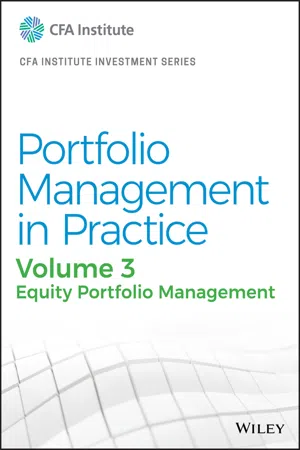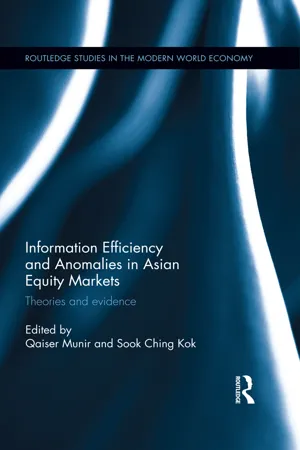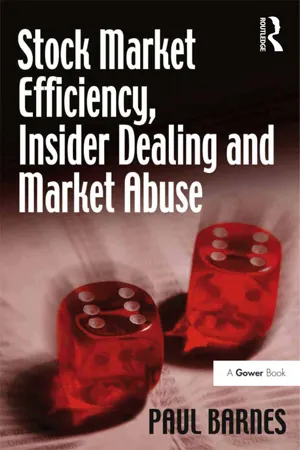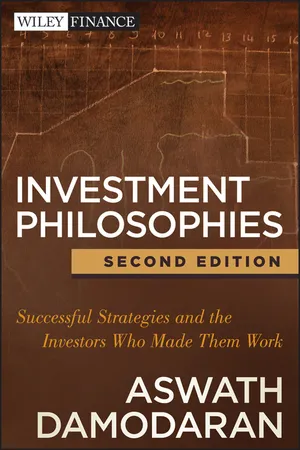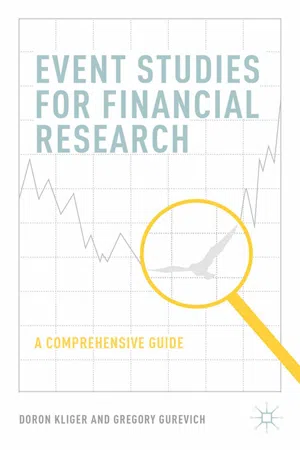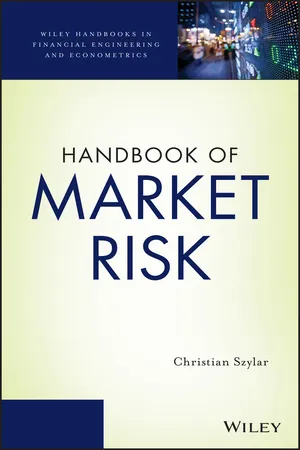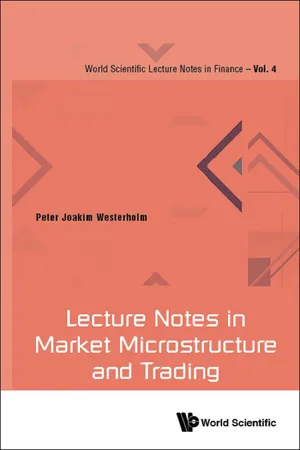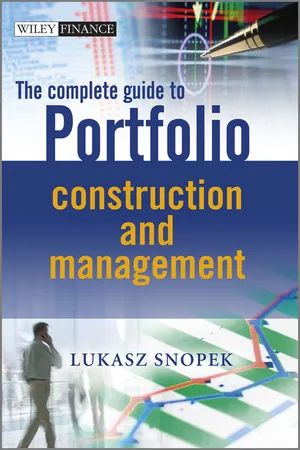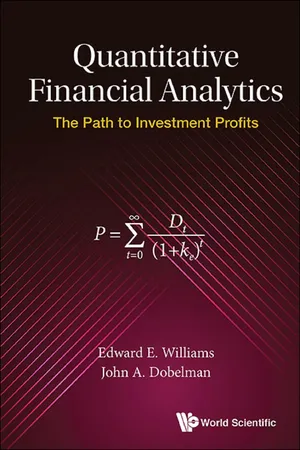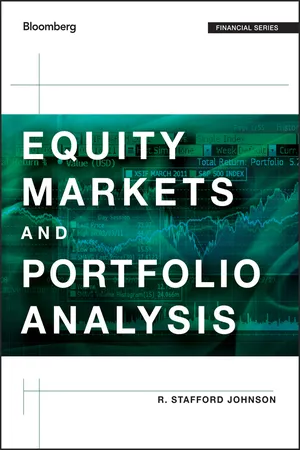Business
Strong Form Efficiency
Strong Form Efficiency is a concept in finance that suggests all information, both public and private, is fully reflected in stock prices. In a market that exhibits strong form efficiency, it is impossible to achieve abnormal returns, as all relevant information is already incorporated into stock prices. This implies that even insider information cannot be used to gain an advantage in the market.
Written by Perlego with AI-assistance
Related key terms
12 Key excerpts on "Strong Form Efficiency"
- eBook - ePub
Portfolio Management in Practice, Volume 3
Equity Portfolio Management
- (Author)
- 2020(Publication Date)
- Wiley(Publisher)
strong-form efficient market, security prices fully reflect both public and private information. A market that is strong-form efficient is, by definition, also semi-strong- and weak-form efficient. In the case of a strong-form efficient market, insiders would not be able to earn abnormal returns from trading on the basis of private information. A strong-form efficient market also means that prices reflect all private information, which means that prices reflect everything that the management of a company knows about the financial condition of the company that has not been publicly released. However, this is not likely because of the strong prohibitions against insider trading that are found in most countries. If a market is strong-form efficient, those with insider information cannot earn abnormal returns.Researchers test whether a market is strong-form efficient by testing whether investors can earn abnormal profits by trading on nonpublic information. The results of these tests are consistent with the view that securities markets are not strong-form efficient; many studies have found that abnormal profits can be earned when nonpublic information is used.203.4. Implications of the Efficient Market Hypothesis
The implications of efficient markets to investment managers and analysts are important because they affect the value of securities and how these securities are managed. Several implications can be drawn from the evidence on efficient markets for developed markets:- Securities markets are weak-form efficient, and therefore, investors cannot earn abnormal returns by trading on the basis of past trends in price.
- Securities markets are semi-strong efficient, and therefore, analysts who collect and analyze information must consider whether that information is already reflected in security prices and how any new information affects a security’s value.21
- Securities markets are not strong-form efficient because securities laws are intended to prevent exploitation of private information.
3.4.1. Fundamental Analysis
Fundamental analysis - eBook - ePub
Investments
Principles of Portfolio and Equity Analysis
- Michael McMillan, Jerald E. Pinto, Wendy L. Pirie, Gerhard Van de Venter(Authors)
- 2011(Publication Date)
- Wiley(Publisher)
19 3.3. Strong FormIn the strong form of efficient markets, security prices fully reflect both public and private information. A market that is strong-form efficient is, by definition, also semistrong- and weak-form efficient. In the case of a strong-form efficient market, insiders would not be able to earn abnormal returns from trading on the basis of private information. A strong-form efficient market also means that prices reflect all private information, which means that prices reflect everything that the management of a company knows about the financial condition of the company that has not been publicly released. However, this is not likely because of the strong prohibitions against insider trading that are found in most countries. If a market is strong-form efficient, those with insider information cannot earn abnormal returns.Researchers test whether a market is strong-form efficient by testing whether investors can earn abnormal profits by trading on nonpublic information. The results of these tests are consistent with the view that securities markets are not strong-form efficient; many studies have found that abnormal profits can be earned when nonpublic information is used.203.4. Implications of the Efficient Market HypothesisThe implications of efficient markets to investment managers and analysts are important because they affect the value of securities and how these securities are managed. Several implications can be drawn from the evidence on efficient markets for developed markets: - eBook - ePub
Information Efficiency and Anomalies in Asian Equity Markets
Theories and evidence
- Qaiser Munir, Sook Ching Kok(Authors)
- 2016(Publication Date)
- Routledge(Publisher)
The third camp of EMH literature is based on the strong-form tests. We notice that there are fewer studies of strong-form efficiency than of weak form and semi-strong form. The existing studies, however, show that the strong-form tests are important in assessing the profitability of insider information. It is quite usual to conclude that the market is inefficient in the presence of insider profits. For instance, over the period January 1992 through December 1996, Brio, Miguel and Perote (2002) show that in the Spanish stock market insiders earn higher returns when investing with corporate private information but outsiders are unable to obtain such excess profits. Khan and Ikram (2011) found evidence that mutual funds outperformed the market in India over the period 1 April 2000 through 30 April 2010. Thus, it is concluded that the Indian capital market is strong-form inefficient. Differing from the preceding studies, Chau and Vayanos (2008) infer strong-form market efficiency in the presence of monopolistic insiders. They studied a sample from the US stock market which consists of a large-cap stock (Coca-Cola) and a small cap stock (Bairnco). In their findings, as the monopolistic insiders reveal their information quickly, the market approaches continuous trading while insiders’ profits do not converge to zero.7.0 Conclusions
This chapter has discussed the background of equity market informational efficiency, efficient market theories (the theory of efficient capital markets, the theory of random walks), the EMH and its implications, technical analysis, fundamental analysis, and the developing trends in the EMH literature. Our discussion has focused on the intellectual history of the EMH, which enables us to provide a clear picture of the underlying theories and core concepts as well as the research in this field.The EMH has a strong foundation, and to date it has remained very important to dictate the behaviour of stock prices. A perfectly efficient market may seem to be unrealistic, as arbitrage activities are constrained by information and transaction costs. In addition, it is possible that insiders’ profits are available in equity markets. This suggests that strong-form efficiency is unlikely to happen. However, recent studies, such as Chau and Vayanos (2008), prove that markets may be close to strong-form efficiency. Such evidence offers new insight into the validity of EMH. Meanwhile, extensive evidence of weak-form and semi-strong-form efficiencies are documented in the literature, which shows that efficiency varies across different equity markets. Not surprisingly, some markets are found to be inefficient either in the weak-form or semi-strong-form sense. Thus, the roles played by technical analysis and fundamental analysis are important. In the presence of market inefficiency, the precision of stock price forecasting will be great, depending on the methods used. Analysts need more advanced methods as markets become more efficient. We notice that there are some new inventions, such as the Suzuki and Ohkura (2016) technical indicator and the Shen and Tzeng (2015) combined soft computing model. - Paul Barnes(Author)
- 2016(Publication Date)
- Gower(Publisher)
Most of the early studies of the semi-strong form were ‘event studies’. These studied the stock market reaction to the announcement of a new piece of information both during the days prior to, and after, the event. They compared the ‘expected’ normal return (based on the market as a whole for the same period) for a sample of shares that had experienced such an event over the period surrounding the event with their actual returns. The difference between the two (expected and actual returns) is referred to as the abnormal return and interpreted as the change in the share price in excess of the market caused by the event or new piece of information. Most studies have used what is known as the Market Model (see the Appendix in this chapter for a mathematical specification of this). If the abnormal returns were statistically significant and occurred prior to, or immediately after, the event or release of new information, they would be regarded as evidence to support the ECMH. Invariably, the evidence from these short-window event studies was consistent with market efficiency.THE STRONG FORM
This states that current market prices reflect all relevant information, whether publicly available or privately held. It is generally believed that all large stock markets are efficient in the weak and semi-strong forms but they are not efficient in the strong form and that insiders and others who profit from inside information exist on a fairly large scale. Whilst academics have had access to the necessary information to test the other forms of the ECMH, they are usually unable to test the strong form because of the secrecy of inside traders. They have usually only been able to go so far as to infer from observed market reactions prior to the announcement of an important piece of news that insider dealing has occurred and on such a large scale as to cause share prices to change (Barnes 1996). These studies are reviewed in Chapter 9 .Problems with the ECMH
For many years, there was general agreement between academics about the ECMH and that in the words of Fama (1970) ‘the evidence in support of the efficient markets model is extensive and (somewhat uniquely in economics) contradictory evidence is sparse’ (p. 416). However, stock market crises and closer examination of share price behaviour have suggested a degree of inefficiency. We will look at the implications of the crises later but, more recently, the view has emerged that whilst share prices undoubtedly do adjust to new information, they do not necessarily do this instantaneously and, more importantly, they tend to overreact and may not discriminate between differences in the quality of information (Kothari 2001). Frankel and Lee (1998) write ‘Price convergence to value is a much slower process than prior evidence suggests.’ Almost all of the evidence is from the US, but it is reasonable to presume that the situation is similar in the UK. Certainly, there is no reason to suppose the UK markets are more efficient than those in the US.- eBook - ePub
Investment Philosophies
Successful Strategies and the Investors Who Made Them Work
- Aswath Damodaran(Author)
- 2012(Publication Date)
- Wiley(Publisher)
2 Under weak form efficiency, the current price reflects the information contained in all past prices, suggesting that charts and technical analyses that use past prices alone would not be useful in finding undervalued stocks. Under semiStrong Form Efficiency, the current price reflects the information contained not only in past prices but in all public information (including financial statements and news reports), and no approach predicated on using and massaging this information would be useful in finding undervalued stocks. Under Strong Form Efficiency, the current price reflects all information, public as well as private, and no investors will be able to consistently find undervalued stocks.Implications of Market EfficiencyAn immediate and direct implication of an efficient market is that no group of investors should be able to consistently beat the market using a common investment strategy. An efficient market would also carry negative implications for many investment strategies.- In an efficient market, equity research and valuation would be a costly task that would provide no benefits. The odds of finding an undervalued stock would always be 50–50, reflecting the randomness of pricing errors. At best, the benefits from information collection and equity research would cover the costs of doing the research.
- In an efficient market, a strategy of randomly diversifying across stocks or indexing to the market, carrying little or no information cost and minimal execution costs, would be superior to any other strategy that created larger information and execution costs. There would be no value added by portfolio managers and investment strategists.
- In an efficient market, a strategy of minimizing trading (i.e., creating a portfolio and not trading unless cash is needed) would be superior to a strategy requiring frequent trading.
It is therefore no wonder that the concept of market efficiency evokes such strong reactions on the part of portfolio managers and analysts, who view it, quite rightly, as a challenge to their very existence.It is also important that there be clarity about what market efficiency does not imply. An efficient market does not imply that: - eBook - ePub
Event Studies for Financial Research
A Comprehensive Guide
- D. Kliger, G. Gurevich(Authors)
- 2014(Publication Date)
- Palgrave Macmillan(Publisher)
7Having debated the weak form of EMH, we turn now to elaborate on the other pole of the efficiency spectrum, namely its strong form. As Jensen (1978) points out, the strong form of EMH is hardly ever taken seriously by anyone. Rather, this form serves mainly as an extreme condition that completes the set of theoretical possibilities. In the same vein, Fama (1970) views strong efficiency not as an empirical possibility but rather as “a benchmark against which deviations from market efficiency (interpreted in its strictest sense) can be judged” (415).Grossman and Stiglitz (1980) demonstrated that in real markets in which data collecting is not necessarily free, security prices reflect only the information whose benefits do not fall below the costs of obtaining it, corroborating the conclusion that the strong form of EMH is unlikely. Fama (1991) discusses a range of studies showing that insider trading permits generating extra profits, thereby empirically refuting the Strong Form Efficiency. Therefore, the semistrong form of EMH has received the most attention from both theoreticians and empiricists. ESA is primarily designed to deal with this version of EMH. Henceforth, thus, in discussing efficiency, we refer to the semistrong form, unless we explicitly state otherwise.The semistrong form of EMH postulates that investors take advantage of every piece of useful and publicly available information, and market prices, therefore, reflect everything relevant at any given moment. As a consequence, news arrival must bring about an immediate market reaction, and because news, by definition, is always unexpected, the conduct of market prices is unpredictable. - eBook - ePub
- Christian Szylar(Author)
- 2013(Publication Date)
- Wiley(Publisher)
In its strongest form, the EMH says a market is efficient if all information relevant to the value of a share, whether or not generally available to existing or potential investors, is quickly and accurately reflected in the market price. For example, if the current market price is lower than the value justified by some piece of privately held information, the holders of that information will exploit the pricing anomaly by buying the shares. They will continue doing so until this excess demand for the shares has driven the price up to the level supported by their private information. At this point they will have no incentive to continue buying, so they will withdraw from the market and the price will stabilize at this new equilibrium level. This is called the strong-form EMH. It is the most satisfying and compelling form of EMH in a theoretical sense, but it suffers from one big drawback in practice. It is difficult to confirm empirically, because the necessary research would be unlikely to win the cooperation of the relevant section of the financial community—insider dealers.2.2.2 Semi-Strong EMH
In a slightly less rigorous form, the EMH says a market is efficient if all relevant publicly available information is quickly reflected in the market price. This is called the semi-strong EMH. If the strong form is theoretically the most compelling, then the semi-strong form perhaps appeals most to our common sense and is closer to the real world. It says that the market will quickly digest the publication of relevant new information by moving the price to a new equilibrium level that reflects the change in supply and demand caused by the emergence of that information. What it may lack in intellectual rigor, the semi-strong EMH certainly gains in empirical strength, because it is less difficult to test than strong EMH.One problem with the semi-strong EMH lies with the identification of “relevant publicly available information”. Neat as the phrase might sound, the reality is less clear-cut, because information does not arrive with a convenient label saying which shares it does and does not affect.2.2.3 Weak-Form EMH
In its third and least rigorous form (known as the weak form), the EMH confines itself to just one subset of public information, namely historical information about the share price itself. The argument runs as follows. “New” information must by definition be unrelated to previous information, otherwise it would not be new. It follows from this that every movement in the share price in response to new information cannot be predicted from the last movement or price, and the development of the price assumes the characteristics of the random walk. In other words, the future price cannot be predicted from a study of historic prices. - Peter Joakim Westerholm(Author)
- 2018(Publication Date)
- WSPC(Publisher)
I have personally tried to invest money, my client’s and my own, in every single anomaly and predictive result that academics have dreamed up. That includes the strategy of DeBondt and Thaler (that is, sell short individual stocks immediately after one-day increases of more than 5%), the reverse of DeBondt and Thaler which is Jegadeesh and Titman (buy individual stocks after they have decreased by 5%), etc. I have attempted to exploit the so-called year-end anomalies and a whole variety of strategies supposedly documented by academic research. And I have yet to make a nickel on any of these supposed market inefficiencies.•Clearly, technical analysis has its share of critics. Warren Buffet was quoted saying, “I realized technical analysis didn’t work when I turned the charts upside down and didn’t get a different answer.”•Most apparent incidences of mispricing seem eliminated by transactions costs. The primary exceptions to weak form market efficiency seem to be the IPO effect, probably the January effect, perhaps the small firm effect, and perhaps the P/E effect.•There is little agreement as to why these effects persist or even if the latter two do exist, they are anomalies.Semi-Strong Form Efficiency•Semi-Strong Form Efficiency tests are concerned with whether security prices reflect all publicly available information.•For example, how much time is required for a given type of information to be reflected in security prices? What types of publicly available information might an investor use to generate higher than normal returns?•The vast majority of studies of semi-strong form market efficiency suggest that the tested publicly available information and announcements cannot be used by the typical investor to secure significantly higher than normal returns.Early Tests•Cox [1930] found no evidence that professional stock analysts could outperform the market.•Cowles [1933] performed several tests of what was later to be known as the efficient market hypothesis (EMH). He examined the forecasting abilities of 45 professional securities analysis agencies, comparing the returns that might have been generated by professionals’ recommendations to actual returns on the market over the same period.- Lukasz Snopek(Author)
- 2012(Publication Date)
- Wiley(Publisher)
4 Event studies can be used to determine different price reactions following the release of information.Prices may adjust immediately, thus implying that the market is efficient. However, when the price takes some time (several days or even months) to incorporate the information, this is referred to as under- or overreaction that can be exploited by investors.Most studies show that investors react quickly, and that it is illusory to hope to make excess returns by trading on information such as dividend announcements, bonus share issues, stock repurchases, acquisitions, mergers, changes in accounting policies, etc. Nonetheless, some recent results show slow adjustment to events such as earnings announcements.5We will examine investors' under- and overreaction to information in more detail at a later stage. At this point, we can assume that all publicly available information is not immediately reflected in prices, implying a certain level of market inefficiency.6.3 Strong Form Market Efficiency“Finally, a market is strong form efficient if prices incorporate all past, public and private information . In this case, it is impossible to earn returns in excess of the market using insider information.”6However, in practice, the existence of insider trading invalidates this form; “abnormal” profits can be generated although this constitutes an illegal practice. Independently of any possibility of insider news, so-called pockets of inefficiency may exist. These take time to be corrected and to return to a situation of market equilibrium and efficiency.Furthermore, “information is not a free resource ; it entails acquisition costs that may be high. This is the case for many tools and services used by portfolio managers and traders. So this cost must be included in the definition of efficiency, particularly for testing the strong form. It was Grossman and Stiglitz (1980) who showed that prices should not perfectly reflect information.”7 Thus, “an investment fund, which requires constant information processing, must make a return in excess of the average market return to compensate for the cost of this information. If the fund's return exceeds market return and management costs, the market may then be considered inefficient.”8 Of course, there are fund managers who succeed in beating the market after deduction of transaction costs, but they are unable to do so repeatedly, year after year. While the important role played by luck- eBook - ePub
Quantitative Financial Analytics
The Path to Investment Profits
- Edward E Williams, John A Dobelman;;;(Authors)
- 2017(Publication Date)
- WSPC(Publisher)
In a crude sense, it could be said that the weak tests indicate that one cannot become wealthy as a technician (forecasting price or return movements based on past behavior), and the semi-strong tests indicate that, by the time one reads some new information, it is too late to profit from it. The theory still allows a person possessing superior information or analytical techniques to expect a better-than-normal return. A third form of testing (called the “strong efficient market hypothesis”) went all the way to asking if there can be any information not reflected in the price of a security such that anyone can expect above-average profits. During the 1920s, it was claimed that “any day is a good day to buy a good stock.” If the strong form of the efficient capital market hypothesis held, then, “any day is as good as any other day to buy any stock (or bond, or mutual fund, and so on).”The rationale for the strong tests lies in a combination of the semi-strong tests (information assimilated in a rapid and unbiased fashion) and the fact that a great many supposedly knowledgeable and trained people are engaged in the securities business. It is argued that with so many people and so much information, there should be few if any true “sleepers.” Studies have indicated that corporate insiders may have superior information and thus higher expected returns. Other investors, however, have not been shown to produce consistently higher returns. In particular, numerous studies of mutual funds have shown that their average performance is, if anything, inferior to the market as a whole.It also appears that, even for individual funds, past success is an unreliable guide to future performance. In sum, it has been shown that the investor could do better picking securities at random than with the average mutual fund. And, because mutual funds are viewed as possessing as much information, analytical skill, and diversification as any investor, their inability to out-perform the market is taken as very compelling evidence in support of the strong form of the efficient markets hypothesis. It should be noted, however, that even in academic circles, the strong form has a much smaller following than the other two tests. - eBook - ePub
- R. Stafford Johnson(Author)
- 2014(Publication Date)
- Bloomberg Press(Publisher)
For example, investors/fundamentalists may be too bullish about an unexpected good earnings announcement, causing the market price to overshoot its equilibrium value. Upon further assessment, the market may correct by slowing purchases or selling, causing the price to move down. During this reassessment period, the volatility of the stock price may increase. Semi-strong-form tests of the EMH do not rule out the possibility that during the assessment period some investors may pay less than the new equilibrium price and thus earn abnormal returns, whereas others may pay more than the equilibrium price and therefore earn returns less than the equilibrium return. Instead, the semi-strong-form tests try to determine if there are enough fundamentalists to ensure that investors, on average, do not earn abnormal returns from trading from events and announcements. As a result, the null hypothesis for the semi-strong-form tests, H ss 0, is: H ss 0 : Investors, on average, cannot earn abnormal returns from trading strategies based on publicly available information. Strong-form tests of the EMH are tests of whether all information—public and private—is fully reflected in the security's price. These tests usually take two forms. One form tries to determine whether or not insiders can earn abnormal returns from their private information. That is, do the officers, managers, engineers, scientists, accountants, and others in the company, as well as those who by the nature of their business are close to the company, have private information that would allow them to earn abnormal returns? In the United States and many other countries, there are security laws that require that insiders list their trades with the SEC. The intent of the laws is to make publicly available trades that are based on privileged information. If these and other laws aimed at inside trading are effective, then a priori we would expect security prices to reflect inside information - eBook - ePub
The Long and the Short of It (International edition)
A guide to finance and investment for normally intelligent people who aren't in the industry
- John Kay(Author)
- 2016(Publication Date)
- Profile Books(Publisher)
You regularly hear statements like these in popular discussion. The weak form of the efficient market hypothesis claims that no such statement can ever be justified because prices move without knowledge of their history. The probability that they will rise next year, or next month, or today, is unaffected by whether prices rose yesterday afternoon, or last week, or in the first quarter of 2011.The weak EMH is a blow for people who rely on projections of historical trends, or identification of recurrent patterns, to make their investment decisions – most of all for chartists, whom I’ll describe in the next chapter. But the weak version does nothing to discourage people from looking at fundamental values. Rather the opposite – the weak EMH encourages you to believe that you might make money at the expense of noise traders by paying close attention to fundamentals.There is a considerable practical difference between weak and strong EMH. Strong EMH – which postulates that everything that could be known about securities is already in their price – essentially rules out any possibility of investment skill. Legendary investors such as Buffett have simply been lucky. No research or analysis can be useful, because its results will be reflected in the market. Put like this, the theory seems absurd.Indeed, the strong version of EMH contains an inherent contradiction. If it were the case that research and analysis could never be profitable, because the result of that research and analysis would always be ‘in the price’, why would anyone undertake such research and analysis? If prices were always efficient, what could be the process by which they become efficient?The semi-strong version of the efficient market hypothesis is less extreme, claiming only that information is ‘in the price’ if publicly available. Thus the semi-strong version does not exclude the possibility that insightful new analysis, unpublished or not yet widely circulated, might be valuable to those who possess it. It certainly permits possibilities of profit from trading on private information. The investment banker who knows of a planned takeover and the corporate executive who knows that the coming results will be worse than is generally expected can both deal advantageously on the basis of this inside information.
Index pages curate the most relevant extracts from our library of academic textbooks. They’ve been created using an in-house natural language model (NLM), each adding context and meaning to key research topics.
